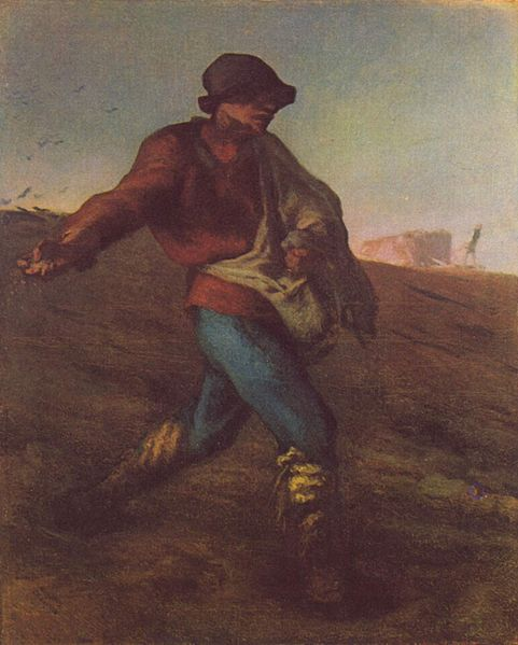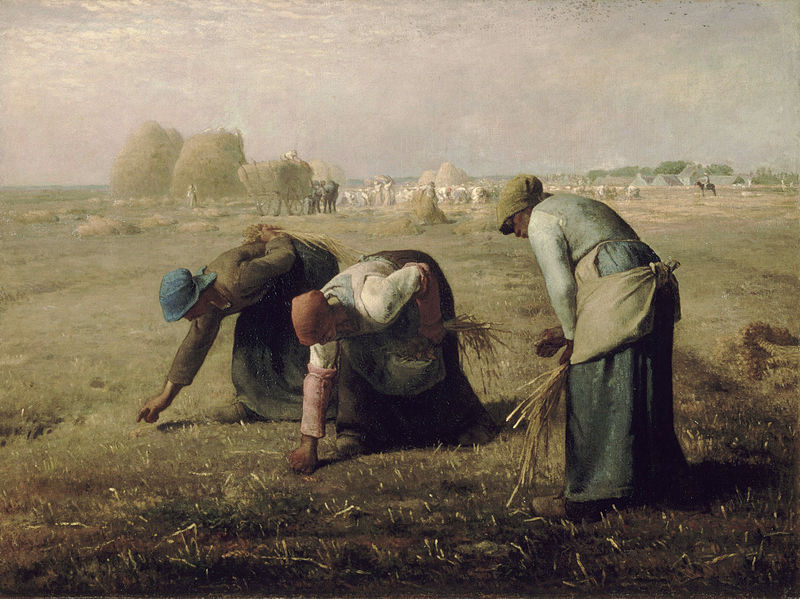
Millet based his work on the fable of the same name by Jean de La Fontaine, which itself is from the fables of Aesop.
Jean de La Fontaine, 1621–1695, La Mort et le Bûcheron. The English translation is from 1917.
Un pauvre Bûcheron tout couvert de ramée,
Sous le faix du fagot aussi bien que des ans
Gémissant et courbé marchait à pas pesants,
Et tâchait de gagner sa chaumine enfumée.
Enfin, n’en pouvant plus d’effort et de douleur,
Il met bas son fagot, il songe à son malheur.
Quel plaisir a-t-il eu depuis qu’il est au monde ?
En est-il un plus pauvre en la machine ronde ?
Point de pain quelquefois, et jamais de repos.
Sa femme, ses enfants, les soldats, les impôts,
Le créancier, et la corvée
Lui font d’un malheureux la peinture achevée.
Il appelle la mort, elle vient sans tarder,
Lui demande ce qu’il faut faire
C’est, dit-il, afin de m’aider
A recharger ce bois ; tu ne tarderas guère.
Le trépas vient tout guérir ;
Mais ne bougeons d’où nous sommes.
Plutôt souffrir que mourir,
C’est la devise des hommes.
A poor woodcutter, covered with green boughs,
Under the fagot’s weight and his own age
Groaning and bent, ending his weary stage,
Was struggling homeward to his smoky hut.
At last, worn out with labor and with pain,
Letting his fagot down, he thinks again
What little pleasure he has had in life.
Is there so cursed a wretch in all the strife?
No bread sometimes, and never any rest;
With taxes, soldiers, children, and a wife,
Creditors, forced toil oppressed,
He is the picture of a man unblessed.
He cries for Death. Death comes straightway,
And asks why he was called upon.
“Help me,” the poor man says, “I pray,
To lift this wood, then I’ll begone.”
Death comes to end our woes.
But who called him? Not I!
The motto of mankind still goes:
We’ll suffer all, sooner than die.

Legros’ etching La Mort et Le Bûcheron is the second in a series of six based on the fable by La Fontaine. A woodcutter, worn down by years of exhaustive labour, summons Death to release him from his endless toil. This particular etching is the best known of the series, and was reproduced in the French periodical “L’Art” in 1876.
Much of Millet’s work shows his concern with the struggle of the peasantry, weighed down with drudgery, poverty and disease.




Salvador Dali was fascinated by this work and insisted that the figures were praying over their dead child. Later X rays showed that Millet had painted over a box like object, similar to a coffin, but there is no proof of his intention. However, it does seem unlikely that an obviously pious couple would bury their child in unconsecrated ground